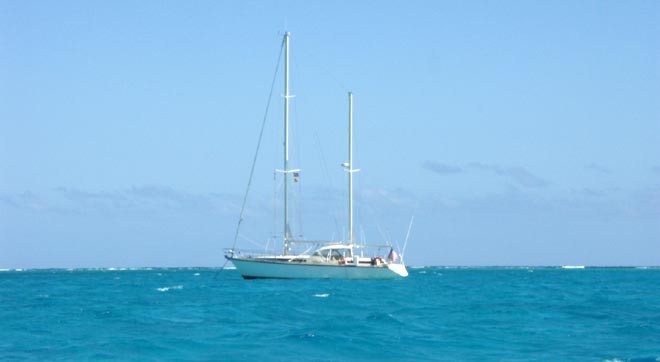Use this simple secret for anchor holding power!
by John Jamieson on 3 May 2012

SW
The other day, a reader sent in a query as to why I recommend a 7: 1 scope on anchor rode as opposed to 3:1. After all, less rode means less hassle with having all that line messed up by gooey mud, slimy bottom crud, and other unknowns beneath the sea.
Use enough scope to match the conditions you anchor in. You scope calculation should include present depth, expected rise to high tide, distance of your depth sounder transducer below the waterline, and freeboard (height of the bow above the water). Add all of these factors up. Multiply by seven for an average scope. Why so much?
Here's a simple, eye-opening demonstration of the power of anchor scope, which is easy for you to do in your home waters:
Grab a small anchor (Five pounds or less--easy to handle). The anchor type isn't important--even a tiny grapnel will do. Attach 20 feet of small diameter line to the anchor shank (long arm of the anchor).
Locate a sandy or soft ground area. Dig the anchor flukes into the ground just a bit. No need to bury them all the way. Walk to the end of your 20 foot anchor line. Turn around and face the anchor. Pull hard on the rope rode. What do you notice?
Your anchor will dig into the simulated 'seabed' and hold well. That's because most of the pull on the anchor rode will be horizontal. And that's the secret to keep your anchor dug deep. You want to do everything possible to keep the rode as parallel as possible to the seabed.
That's another reason to use a length of chain at the seabed end of a rope anchor rode if you are using rope. The chain protects the line from chafe (wear) and it provides weight to keep the rode more parallel to the bottom.
Now, let's simulate what happens with just 3:1. In our experiment, we will assume what the 20 foot piece of rope at the end represents a scope of 7:1. So, about half of that length would represent a scope of close to 3: 1.
Walk slowly toward your anchor. Keep tension on the rope rode as you go. Watch the angle that the rode makes with the anchor and sea bed. Stop when you get to a point about ½ of the distance to the end of the rode.
Look at the shank of your anchor. Note that the rode now has an upward (vertical) pull on the end of the anchor shank. Any vertical pull on an anchor shank has the potential to break out an anchor and cause it to drag. The shorter the rode relative to the water depth, the less chance that your anchor will hold. Avoid short scope for long term or overnight anchoring. Longer scope gives your anchor greater holding power over a broader range of wind or sea condition.
Remember, you will not always anchor on a flat plane of water. Wave action, ground swell, and boat wakes cause your boat to lift and fall in position. As we saw in our experiment, any vertical pull on the anchor will decrease holding power and increase the possibility of break out and dragging. Use longer rode to lessen vertical pull when your boat bow lifts and falls in choppy anchorages.
But what about vessels with all-chain rode? Sure, those with heavy chain might use shorter scope of about 5:1 in light to moderate conditions. But 7:1 will always be better. And, in storm conditions or in unprotected areas with heavy ground swell, you need 10:1. Use the maximum scope possible or set more than one anchor in crowded anchorages with limited swing room.
You will sleep better at night when you choose to use enough scope to keep your boat anchor dug deep into the sea bottom--wherever in the world you choose to cruise!
John Jamieson (Captain John) with 25+ years of experience shows you the no-nonsense cruising skills you need beyond sailing school. Visit his website at www.skippertips.com for a free sailing tips newsletter. Become a member for instant access to 550+ sailing skills articles, 100+ sailing video tutorials, 145+ sailing tips newsletters, 12+ sailing topic e-Books, and more!
If you want to link to this article then please use this URL: www.sail-world.com/96785